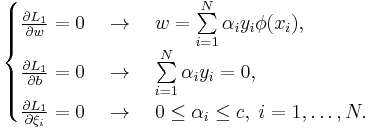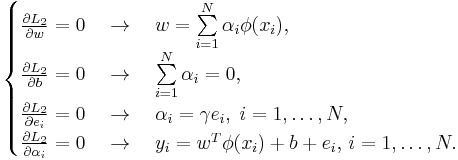Least squares support vector machine
Least squares support vector machines (LS-SVM) are least squares versions of support vector machines (SVM), which are a set of related supervised learning methods that analyze data and recognize patterns, and which are used for classification and regression analysis. In this version one finds the solution by solving a set of linear equations instead of a convex quadratic programming (QP) problem for classical SVMs. Least squares SVM classifiers, were proposed by Suykens and Vandewalle.[1] LS-SVMs are a class of kernel based learning methods.
Contents |
From support vector machine to least squares support vector machine
Given a training set  with input data
with input data  and corresponding binary class labels
and corresponding binary class labels  , the SVM[2] classifier, according to Vapnik’s original formulation, satisfies the following conditions:
, the SVM[2] classifier, according to Vapnik’s original formulation, satisfies the following conditions:
Which is equivalent to
where  is the nonlinear map from original space to the high (and possibly infinite) dimensional space.
is the nonlinear map from original space to the high (and possibly infinite) dimensional space.
Inseparable data
In case of such separating hyperplane does not exist, we introduce a so called slack variable  such that
such that
According to the structural risk minimization principle, the risk bound is minimized by the following minimization problem:
where  are the Lagrangian multipliers. The optimal point will in the saddle point of the Lagrangian function, and then we obtain
are the Lagrangian multipliers. The optimal point will in the saddle point of the Lagrangian function, and then we obtain
By substituting w by its expression, we will get the following quadratic programming problem:
where  is called the kernel function. Solving this QP problem subject to constrains in (8), we will get the hyperplane in the high dimensional space and hence the classifier in the original space.
is called the kernel function. Solving this QP problem subject to constrains in (8), we will get the hyperplane in the high dimensional space and hence the classifier in the original space.
Least squares SVM formulation
The least squares version of the SVM classifier is obtained by reformulating the minimization problem as:
subject to the equality constraints:
The least squares SVM (LS-SVM) classifier formulation above implicitly corresponds to a regression interpretation with binary targets  .
.
Using  , we have
, we have
with 
Hence the LS-SVM classifier formulation is equivalent to
with  and
and 
Both  and
and  should be considered as hyperparamters to tune the amount of regularization versus the sum squared error. The solution does only depend on the ratio
should be considered as hyperparamters to tune the amount of regularization versus the sum squared error. The solution does only depend on the ratio  , therefore the original formulation uses only
, therefore the original formulation uses only  as tuning parameter. We use both
as tuning parameter. We use both  and
and  as parameters in order to provide a Bayesian interpretation to LS-SVM.
as parameters in order to provide a Bayesian interpretation to LS-SVM.
The solution of LS-SVM regressor will be obtained after we construct the Lagrangian function:
where  are the Lagrange multipliers. The conditions for optimality are
are the Lagrange multipliers. The conditions for optimality are
Elimination of  and
and  will yield a linear system instead of a quadratic programming problem:
will yield a linear system instead of a quadratic programming problem:
with ![Y = [y_1 , \ldots ,y_N ]^T](/2012-wikipedia_en_all_nopic_01_2012/I/b107d43702d2b2a76865e7a189d60a85.png) ,
, ![1_N = [1, \ldots ,1]^T](/2012-wikipedia_en_all_nopic_01_2012/I/595ece69e15d09d42453776a66088331.png) and
and ![\alpha = [\alpha _1 , \ldots ,\alpha _N ]^T](/2012-wikipedia_en_all_nopic_01_2012/I/4af004f16cf29462082864ffef042bb7.png) . Here,
. Here,  is an
is an  identity matrix, and
identity matrix, and  is the kernel matrix defined by
is the kernel matrix defined by  .
.
Kernel function K
For the kernel function K(•, •) one typically has the following choices:
- Linear kernel :

- Polynomial kernel of degree
 :
: 
- Radial basis function RBF kernel :

- MLP kernel :

where  ,
,  ,
,  ,
,  and
and  are constants. Notice that the Mercer condition holds for all
are constants. Notice that the Mercer condition holds for all  and
and  values in the polynomial and RBF case, but not for all possible choices of
values in the polynomial and RBF case, but not for all possible choices of  and
and  in the MLP case. The scale parameters
in the MLP case. The scale parameters  ,
,  and
and  determine the scaling of the inputs in the polynomial, RBF and MLP kernel function. This scaling is related to the bandwidth of the kernel in statistics, where it is shown that the bandwidth is an important parameter of the generalization behavior of a kernel method.
determine the scaling of the inputs in the polynomial, RBF and MLP kernel function. This scaling is related to the bandwidth of the kernel in statistics, where it is shown that the bandwidth is an important parameter of the generalization behavior of a kernel method.
Bayesian interpretation for LS-SVM
A Bayesian interpretation of the SVM has been proposed by Smola et al. They showed that the use of different kernels in SVM can be regarded as defining different prior probability distributions on the functional space, as ![P[f] \propto \exp \left( { - \beta \left\| {\hat Pf} \right\|^2 } \right)](/2012-wikipedia_en_all_nopic_01_2012/I/4f209e9137c622a85a1c1341d492005f.png) . Here
. Here  is a constant and
is a constant and  is the regularization operator corresponding to the selected kernel.
is the regularization operator corresponding to the selected kernel.
A general Bayesian evidence framework was developed by MacKay,[3][4][5] and MacKay has used it to the problem of regression, forward neural network and classification network. Provided data set  , a model
, a model  with parameter vector
with parameter vector  and a so called hyperparameter or regularization parameter
and a so called hyperparameter or regularization parameter  , Bayesian inference is constructed with 3 levels of inference:
, Bayesian inference is constructed with 3 levels of inference:
- In level 1, for a given value of
 , the first level of inference infers the posterior distribution of by Bayesian rule
, the first level of inference infers the posterior distribution of by Bayesian rule
- The second level of inference determines the value of
 , by maximizing
, by maximizing
- The third level of inference in the evidence framework ranks different models by examining their posterior probabilities
We can see that Bayesian evidence framework is a unified theory for learning the model and model selection. Kwok used the Bayesian evidence framework to interpret the formulation of SVM and model selection. And he also applied Bayesian evidence framework to support vector regression.
Now, given the data points  and the hyperparameters
and the hyperparameters  and
and  of the model
of the model  , the model parameters
, the model parameters  and
and  are estimated by maximizing the posterior
are estimated by maximizing the posterior  . Applying Bayes’ rule, we obtain:
. Applying Bayes’ rule, we obtain:
Where  is a normalizing constant such the integral over all possible
is a normalizing constant such the integral over all possible  and
and  is equal to 1. We assume
is equal to 1. We assume  and
and  are independent of the hyperparameter
are independent of the hyperparameter  , and are conditional independent, i.e., we assume
, and are conditional independent, i.e., we assume
When  , the distribution of
, the distribution of  will approximate a uniform distribution. Furthermore, we assume
will approximate a uniform distribution. Furthermore, we assume  and
and  are Gaussian distribution, so we obtain the a priori distribution of
are Gaussian distribution, so we obtain the a priori distribution of  and
and  with
with  to be:
to be:
Here  is the dimensionality of the feature space, same as the dimensionality of
is the dimensionality of the feature space, same as the dimensionality of  .
.
The probability of  is assumed to depend only on
is assumed to depend only on  and
and  . We assume that the data points are independently identically distributed (i.i.d.), so that:
. We assume that the data points are independently identically distributed (i.i.d.), so that:
In order to obtain the least square cost function, it is assumed that the probability of a data point is proportional to:
A Gaussian distribution is taken for the errors  as:
as:
It is assumed that the  and
and  are determined in such a way that the class centers
are determined in such a way that the class centers  and
and  are mapped onto the target -1 and +1, respectively. The projections
are mapped onto the target -1 and +1, respectively. The projections  of the class elements
of the class elements  follow a multivariate Gaussian distribution, which have variance
follow a multivariate Gaussian distribution, which have variance  .
.
Combining the preceding expressions, and neglecting all constants, Bayes’ rule becomes
The maximum posterior density estimates  and
and  are then be obtained by minimizing the negative logarithm of (26), so we arrive (10).
are then be obtained by minimizing the negative logarithm of (26), so we arrive (10).
References
- ^ Suykens, J.A.K.; Vandewalle, J. (1999) "Least squares support vector machine classifiers", Neural Processing Letters, 9 (3), 293-300.
- ^ Vapnik, V. The nature of statistical learning theory. Springer-Verlag, New York, 1995
- ^ MacKay, D.J.C. Bayesian Interpolation. Neural Computation, 4(3): 415-447, May 1992.
- ^ MacKay, D.J.C. A practical Bayesian framework for backpropagation networks. Neural Computation, 4(3): 448-472, May 1992.
- ^ MacKay, D.J.C. The evidence framework applied to classification networks. Neural Computation, 4(5): 720-736, Sept. 1992.
Bibliography
- J. A. K. Suykens, T. Van Gestel, J. De Brabanter, B. De Moor, J. Vandewalle, Least Squares Support Vector Machines, World Scientific Pub. Co., Singapore, 2002. ISBN 981-238-151-1
- Suykens J.A.K., Vandewalle J., Least squares support vector machine classifiers, Neural Processing Letters, vol. 9, no. 3, Jun. 1999, pp. 293–300.
- Vladimir Vapnik. The Nature of Statistical Learning Theory. Springer-Verlag, 1995. ISBN 0-387-98780-0
- MacKay, D. J. C., Probable networks and plausible predictions—A review of practical Bayesian methods for supervised neural networks. Network: Computation in Neural Systems, vol. 6, 1995, pp. 469–505.
External links
- www.esat.kuleuven.be/sista/lssvmlab/ "Least squares support vector machine Lab (LS-SVMlab) toolbox contains Matlab/C implementations for a number of LS-SVM algorithms."
- www.kernel-machines.org "Support Vector Machines and Kernel based methods (Smola & Schölkopf)."
- www.gaussianprocess.org "Gaussian Processes: Data modeling using Gaussian Process priors over functions for regression and classification (MacKay, Williams)"
- www.support-vector.net "Support Vector Machines and kernel based methods (Cristianini)"
- dlib: Contains a least-squares SVM implementation for large-scale datasets.

![y_i \left[ {w^T \phi (x_i ) %2B b} \right] \ge 1,\quad i = 1, \ldots ,N \, ,](/2012-wikipedia_en_all_nopic_01_2012/I/2bc06b606a85cca89248a9502ef1cb54.png)
![\begin{cases}
y_i \left[ {w^T \phi (x_i ) %2B b} \right] \ge 1 - \xi _i , & i = 1, \ldots ,N ,\\
\xi _i \ge 0, & i = 1, \ldots ,N .
\end{cases}](/2012-wikipedia_en_all_nopic_01_2012/I/0d44184f4c890d103dc50fe0408276a2.png)

![\text{Subject to } \begin{cases}
y_i \left[ {w^T \phi (x_i ) %2B b} \right] \ge 1 - \xi _i , & i = 1, \ldots ,N , \\
\xi _i \ge 0, & i = 1, \ldots ,N ,
\end{cases}](/2012-wikipedia_en_all_nopic_01_2012/I/13c9e613b69b7758b417a5427de9c27c.png)



![y_i \left[ {w^T \phi (x_i ) %2B b} \right] = 1 - e_{c,i} ,\quad i = 1, \ldots ,N .](/2012-wikipedia_en_all_nopic_01_2012/I/be5b607d21284900aa8a7555cd4729db.png)


![\begin{cases}
L_2 (w,b,e,\alpha )\; = J_2 (w,e) - \sum\limits_{i = 1}^N \alpha _i \left\{ { \left[ {w^T \phi (x_i ) %2B b} \right] %2B e_i - y_i } \right\} ,\\
\quad \quad \quad \quad \quad \; = \frac{1}{2}w^T w %2B \frac{\gamma }{2} \sum\limits_{i = 1}^N e_i^2 - \sum\limits_{i = 1}^N \alpha _i \left\{ \left[ w^T \phi (x_i ) %2B b \right] %2B e_i -y_i \right\} ,
\end{cases}](/2012-wikipedia_en_all_nopic_01_2012/I/0b031542eea37c9e0f0fa2e887695348.png)

![\left[ \begin{matrix}
0 & 1_N^T \\
1_N & \Omega %2B \gamma ^{ - 1} I_N
\end{matrix} \right] \left[ \begin{matrix}
b \\
\alpha
\end{matrix} \right] = \left[ \begin{matrix}
0 \\
Y
\end{matrix} \right] ,](/2012-wikipedia_en_all_nopic_01_2012/I/2a39840c7faa1348656c367016986dd7.png)









